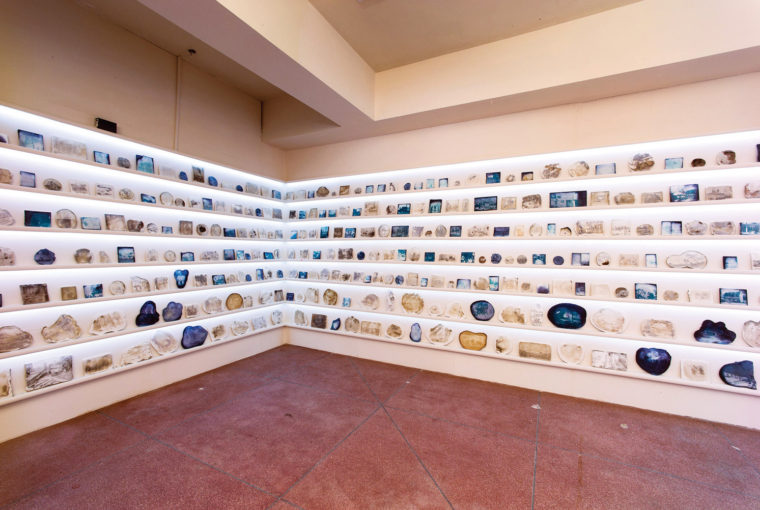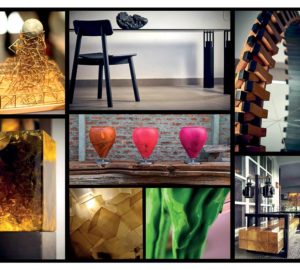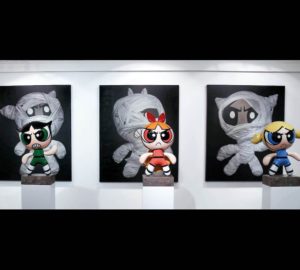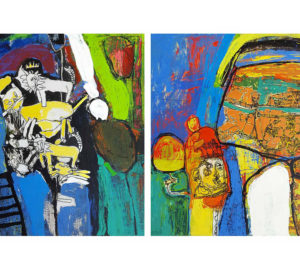
I was invited by the university to write a review about the exhibition, and while reflecting on the artworks, I also considered my position as a curator visiting from London.
Being a curator involves a knowledge of artistic production, art history and the context in which art and the discourse that surrounds it are produced. As a form of specialism, it also creates conditions where the curator becomes a validator of artworks and produces a hierarchy where the few become those qualified to speak about art. With an awareness of these existing hierarchies, I look for ways in which alternative voices can be included. I am interested in the process of making art accessible and how the horizon of contemporary art discourse can be broadened. As SVAD encourages experimentation, the methodology of this piece complements their goal by experimenting with alternative modes of review writing.
Below is an extract of a conversation I had with my cousin Shahryar Beg, a 22-year-old musician and law student who visited the show with me. We discussed the various themes and approaches of the artists and the context in which young artists in Lahore are currently making work. By sharing the platform I have been given, this experimental piece is reflective of the ways in which alternative voices can be included in art discourse. The piece challenges my own position as a validator or narrator within art and this review is a deliberate collaboration with someone who falls outside the critic, curator, writer matrix. As we drove home from the exhibition, I asked Shahryar about his initial impression of the artworks and the show as a whole…
SB: I really enjoyed it. It had a really experiential quality to it and I felt the ideas were accessible. Muqaddas Babar’s work for example, the purpose is to climb and engage with her sculptures on a personal level. Her work isn’t just about what she is trying to represent – it’s her capacity, through the work to alter how you feel in that moment. I climbed two of her works, they were quite tall, they didn’t feel very stable…in fact they had just the right amount of wobble to making the climb terrifying, but when you got to the top the experience was surreal.
MZ: What do you mean by surreal?
SB: The worked engaged me in a physical way – but it managed to alter my state of mind at that point. It was more than just visually or formally appealing, it was something that managed to change the way I was feeling by terrifying me and then giving me an overwhelming sense of calm.
Another artist that managed to tease out an emotional response was Naima Khan. Her work was based on her insecurities and managed to evoke a feeling of discomfort within the viewer. There was the piece where someone was having something poured into their ear. Her works drew on her own emotions while being a catalyst for those emotions to be stirred in the viewer.
MZ: What about some of the other works that were not addressing the artists’ personal experiences or struggles? There were works that were addressing broader themes. I’m thinking in particular of the work by Afifa Mirza. This caught my attention due to my interest in art that is located in the public realm. My interest in art presented outside the gallery space started when I first encountered works by artists like Robert Smithson. This was back in the 90s. Since then I have explored the various ways in which ‘public art’ or ideas around art in the public domain have evolved. This piece struck me because it was making an interesting point about the relationship between an object and the space it inhabits. It also got me thinking about the existence of art in the public domain and also public space itself in Lahore.
SB: Initially I did not understand her work but the last conversation I had at the show was with Afifa. Through that conversation I realised that her work was incredible. She’s gone really far into her investigation of the relationship between space and object and the different ways one can read that relationship. I realised that this is something I had often thought about but her articulation made me consider the numerous ways in which one can think about this idea.
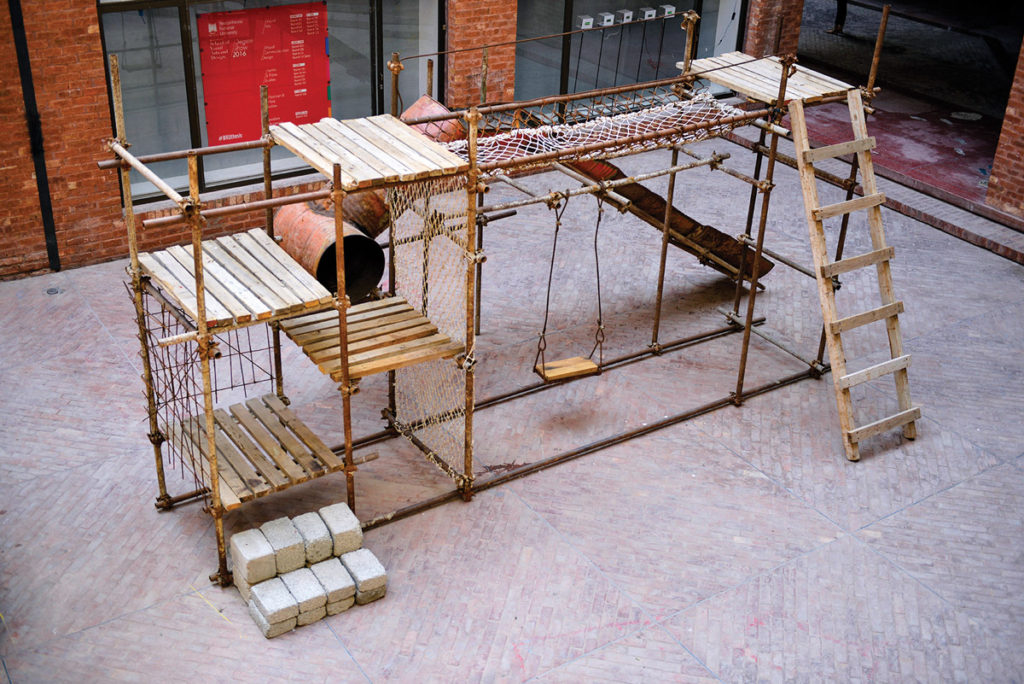
For me sculpture is the most successful medium that opens doors to experimentation and allows the viewer to interact with it. I look at it formally and expect the viewer
to create his/her own playground around it. Ghosts of certain incidents in life never really leave one’s side.
The basic forms of my sculptures come from my childhood memories and experiences and the process of constructing them is where the childlike playfulness begins. By focusing on techniques and materials I try to develop forms that do not follow the logical criteria, but are based only on subjective associations which incite the viewer to make new personal associations. The sculptures are a blend of both art and architecture.
MZ: That highlighting of space and object and how one influences or is influenced by the other is something I am constantly reflecting on. Thinking more broadly about this, particularly from an economic perspective, some works could be seen as comments on the production of art itself; how art relates to its economic surroundings and what it has become as a result of those surroundings.
SB: I did read some of the work and their production from a Marxist perspective. In the Textile & Fibre studies part of the exhibition I saw that Asra Shahid had put price tags on the work. That was really interesting because for me art is about ideas, its value is based on the ideas it is born of and how it manages to engage the viewer with those ideas. The fact that Asra included the price tags portrays an alternative purpose of art, or a different goal altogether. The idea of an economic value was highlighted and sat alongside the presentation of an idea via the objects. It was quite a layered work. Within the mind of the student there sits the economic value placed on their own production. But saying that, how deliberate that was, is not for me to comment on.
MZ: It was interesting how that work managed to bring together technique, weaving, carpets, design, colour, domestic object, and also made reference to the other forms of value and pressures that exist. And like Afifa’s work – they both managed to get you thinking about wider backdrops against which these young artists are currently working. I wonder how much the artists are aware of Lahore’s own Marxist history?
SB: I know very little about Lahore’s Marxist history but not enough to be able to comment, but it’s surprising how much even students are exposed to the market. A lot of the art students I know say they are often asked if anything sold at their end of year show. The idea that your success at a thesis show is measured by whether or not you sold a work – that in itself I think may be part of the reason why so many artists are involved in the production of an object. I feel that the search to create a marketable product is potentially quite damaging for the advancement of ideas. I don’t feel that thinking at college or university level should really come with that burden or expectation. But at the same time I don’t blame an artist for it because ultimately they want to make money from their work, so at some point the economic and market forces will be something they will be considering – it’s how they navigate that and how the ideas can thrive in spite of that or make reference to that which adds more layers to the work. It’s clear that economy and art are intertwined and at the end of the day, [laughs] Marx might be turning in his grave, but you need to make money in order to survive and if you’re going to pursue something that you love, it has to, in our present time, become a commodity.
MZ: Some of the artists were not making an object for sale, for example, Sara Aslam’s work where she grew plants – the installation looked more like a garden centre or the laboratory of a botanist. One of the themes that came to my mind was time. Sara Aslam’s plants were at a particular stage at the time of their presentation and are probably already bigger just a few days later so they embody a natural time. Ayesha Rumi’s installation of images slowly fading over time and the items growing in the laboratory in petri dishes also got me thinking about time. So we caught a moment of growth and erasure which made us both witnesses at only one stage in the process or life of that work. In many ways they act as counterpoints to ideas of permanence. Neither of those two works are ever going to remain how we saw them.
SB: Yeah I loved how those works engaged you with the present moment. The fact that you were able to be a witness to work at a point in its own lifecycle made you really aware of time. Again for me they were experiential but not like the sculptures I climbed. These installations gave the illusion of permanence on first entry but when you stopped to consider what was happening in each work, plants being grown and pictures slowly fading, you started to think more about that moment at which we were a witness and the changes that came just before and those that were yet to come.
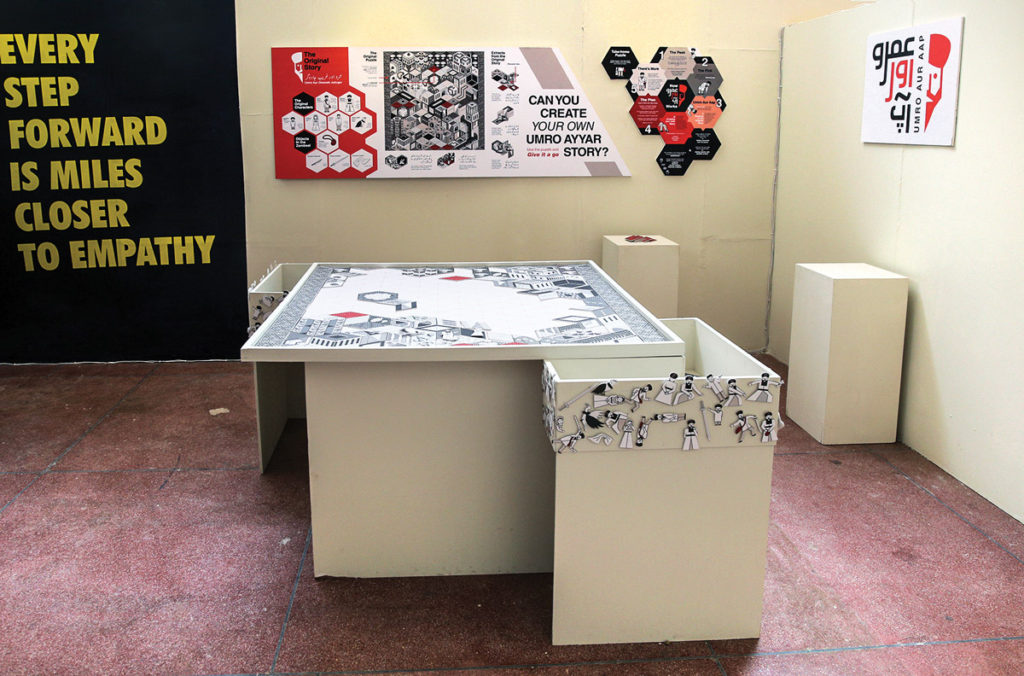
MZ: This idea of being a witness…. we were witnesses to the works, witnessed the artists’ ability to foreground issues, and also the tools they are using today to have a voice. The tensions that were highlighted were both personal but also reflected broader social tensions and concerns…
SB: And we were also witnesses to power and the privilege of the few to be able to have a voice. It was interesting the direction and precision with which they chose to use that power. That power and capacity to comment was applied to personal issues or used to reflect broader issues, it highlighted a broad spectrum of approaches.
Power relationships exist in every structure. It’s not necessarily just in art, it’s everywhere, be it within the home, in every community and sphere. Work that we have been looking at indicates power from many perspectives. So Samia Khan’s works are a reflection of many problems that women face in a society but her narrative reflected her own life.
She made herself the subject and the author of domestic and social power issues. Another artist who tackled power and domestic issues was Hira Tahir Mirza. Her work presents two crows and a cup of tea that overflowed and eventually spilled, acting as a metaphor for the nuances and intricacies of Pakistani family life. Her articulation removed herself from the story and in doing so made space for us as the viewer to engage more broadly with the relational and emotional issues. It’s a real skill to be able to use your own emotion as a starting point but broaden the work so people feel they can connect with the ideas.
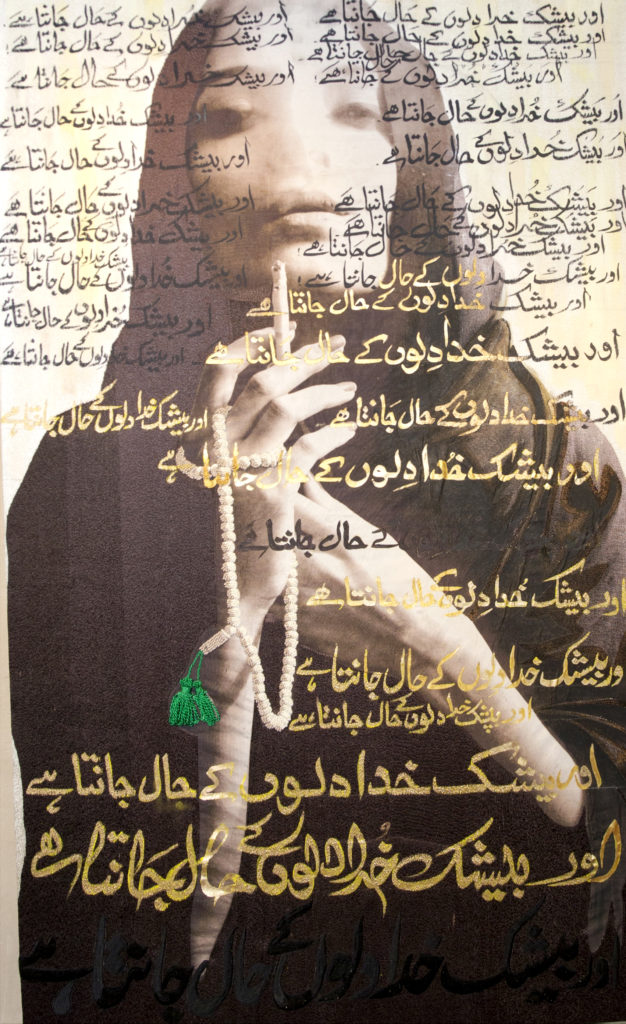
MZ: Talking of how an artist uses their power, as a musician, what did you think about Hashir Buhkari and Alina Tauseef’s work?
SB: Hashir Bukhari produced work that focussed on the experience of music. As a musician I saw his piece as a way to make music accessible to people who don’t learn the technique on a specific instrument. For me his work removed the fear of the instrument. You didn’t think, ‘I can’t play this’ –you just sat down and worked with a familiar object like a typewriter without the pressure or fear of playing something incorrectly. Same with the drawers, you can’t mess up opening drawers so you didn’t fear the notes those drawers might play. Sure the objects were instruments of a kind, the keys on the typewriter and the drawers had specific notes assigned to them – but by placing those notes outside of the known pool of instruments, he created a platform to play music without the fear of mistakes. He basically said there was no right way to play and that is something liberating.
It’s interesting that someone from a different department also looked at music but she approached it from a different angle entirely. Where Hashir tried to engage non-musicians to be musicians via his work, Alina Tauseef tries to bring out the mind of a musician while he or she is playing. She spoke to a bunch of drummers and asked them what they thought about while they were playing. She devised a machine based on two drum pads and based on how hard you played, those images were revealed to you. She said her aspiration was to provide an insight into the mind of a musician. In a way they are touching on similar themes – both about how a musician’s mind works but they highlighted very different sides of that theme.
Staying on the theme of the power of the artist, another work that I engaged with in Visual Communication Design was the puzzle by Ebaa Khurram. The work points you towards overlooked aspects within our culture. It’s a work about storytelling where the audience can rearrange the outcome. Within the given parameters you’re allowed to shape the story through the visuals that were on display.
So when it comes to the power of the artist and the power of artwork to evoke a feeling, emotion, or alter a thought, I think the whole show reflects what art and artists can possibly achieve.
MZ: I’ll be interested to see where they all go from this point. These students are going to be the part of the future canon of contemporary art in Pakistan. Part of me walked around that show and felt like I could have been anywhere in the world, I feel like there is kind of homogeneity that exists in art. I haven’t fully resolved what I think about this.
SB: I have never thought about this in the context of art production, but in human rights law there are two schools of thought – the universalists and the cultural relativists. The universalists believe that there are ‘fundamental’ human rights that transcend cultural and traditional beliefs and practices. The cultural relativists, on the other hand, criticise the universalists for propagating a purely ‘western’ conception of human rights. The problem is that neither of them can be correct because both of these schools of thought have their flaws – the bigger problem is when you decide that one is superior to the other. But that’s an essay in itself…
MZ: I’ve enjoyed our conversation because I don’t really know law in the way you do. Art theory or philosophy provides various prisms through which artistic production can be thought about, but I think in parallel to this there is room for other fields or alternative ways of thinking to help see things from a new angle. Art in itself has become a space for knowledge production, and the discourse that arises from this sphere has its own specificity and peculiarities. In a way it’s a matrix from which new modes of thinking are being produced… and of course, there are always boundaries and limitations… identifying the boundary and seeing how one might go beyond it is an interesting challenge.


